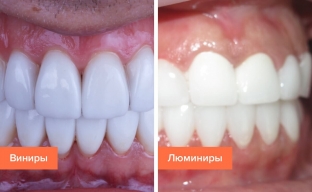Veneers and lumineers are durable plates, intended for the restoration of teeth. With these overlays, you can hide visible teeth imperfections and avoid long-term orthodontic treatment.
There are many differences between veneers and lumineers, but they are often confused. You can find all the details about veneers on the website estet-portal.com, and in this article we will look at the main advantages of each type, find the main differences and find out which option will be the most convenient. Read about the pros and cons of these types of inserts.
What are veneers and lumineers and why are they needed
More recently, the restoration of teeth was considered a complex and expensive operation. However, today everything has changed: thanks to veneers and lumineers, you can quickly and safely achieve a perfect smile.
Orthopedic veneers and lumineers – These are thin overlays that are installed on the front of the front teeth. Their task is to protect and restore damaged or underdeveloped teeth.
The main material for the manufacture of plates is ceramics. In some cases, it is strengthened with porcelain or replaced with zirconia. The minimum service life of veneers is 5 years; on average, linings last one decade.
Veneers or Lumineers are installed when:
- the presence of minor defects: chips, bumps, cracks;
- the need to lengthen or shorten the teeth;
- teeth discoloration;
- crowding and misalignment of teeth;
- presence of underdeveloped teeth.
Veneers and lumineers are often installed for achieve a natural shade of teeth. It should be noted that the overlays can only be installed in the absence of caries and other diseases.
Types of veneers, their main advantages and disadvantages
Dentists distinguish between two methods of placing veneers. The first of them is called therapeutic or composite. Composite veneers are made from a mixture similar to filling material. They are applied in layers and sanded during installation.
Composite veneers will be an excellent solution if you need to correct defects in 1-2 teeth or restore natural color. The main benefits of therapeutic veneers are:
- quick installation;
- relatively low cost.
The main disadvantage of this type of restoration is the fragility of – composite veneers should be renewed every four years.
The second type of veneer is called orthopedic. These veneers are ceramic overlays that are made according to the shape of the patient's teeth. Typically, the manufacturing process of orthopedic veneers takes 1-2 weeks. Temporary overlays are placed on the patient during manufacture.
The strength and durability of the plates is ensured by their thickness. On average, it is 0.5-0.7 mm. In order for the pads to fully adhere to the surface and not look too massive, a small layer of enamel is removed from the teeth. The thickness of the layer to be removed is usually equal to the thickness of the plate.
The need to remove the enamel is the main disadvantage of veneers. A sharpened tooth not only becomes unattractive, but also becomes highly sensitive.
The main advantages of orthopedic veneering are durability and reliability. On average, ceramic plates last more than ten years. In addition, modern veneering involves a very wide range of colors, which allows you to choose the most natural shade.

Pros, cons and main features of Lumineers
Lumineers were created relatively recently – just over 20 years ago. This type of onlay was developed as a safer alternative to veneers. Thanks to artificial crystals, the onlays have gained high strength, which made it possible to make them as thin as possible: the average thickness of lumineers is 0.3 mm. This feature allows you to avoid grinding the tooth, and therefore makes Lumineers safer.
The benefits of Lumineers include:
- Security. After removing the plates, the enamel of the teeth will be in the same condition as before the installation.
- Strength. This type of pads are very durable, which allows them to be used for more than ten years.
- Appearance. With the naked eye, it is quite difficult to see the differences between lumineers and real teeth. Due to this feature, dentists sometimes place a plate not on the entire tooth, but only on the damaged part.
Do not forget that Lumineers are not without flaws. The main disadvantage of this type of restoration – high installation cost. The problem is that real lumineers are currently made only in the USA, and therefore the prices for them include not only the cost of expensive materials, but also shipping from abroad.
In addition, there are cases when, instead of the original plates, dentists offer to install a cheaper analogue. Such lumineers are characterized by low strength and look too massive.
Which is better: veneers or lumineers
As you can see, it is impossible to unambiguously answer which type of restoration plates is better. Each of the varieties has its pros and cons, which allows it to be used for different types of work. Let's try to visually highlight the main differences between veneers and lumineers.
- Setting method. Veneers require the removal of a layer of enamel, while Lumineers are installed on the "pristine" tooth
- Manufacturing method. Orthopedic veneers are made from a cast of the patient's teeth. Lumineers are produced outside of our country according to standard casts.
- Cost. Prices for lumineers are many times higher than the cost of ceramic onlays, since they are made only in the USA using expensive materials: special porcelain and artificial crystals.
- Contraindications. Lumineers can be installed on teeth with a minimum of defects; this type of plate is not used for thinned enamel or a large number of cracks. Veneers are more versatile: they are suitable for restoring teeth with a lot of damage.
Insert type selection should not be done alone. It is best to contact an experienced specialist who will assess the condition of the teeth and help you make a decision. More information about dental and other medical procedures can be found at estet-portal.com.






Add a comment